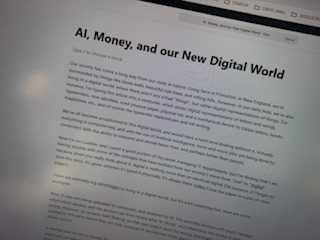
Our society has come a long way from our roots in nature. Living here in Princeton, in New England, we’re surrounded by things like stone walls, beautiful oak trees, and rolling hills. However, in our daily lives, we’re also living in a digital world, where there aren’t any actual “things”, but rather digital representations of things. For instance, I’m typing this article into a computer, which stores digital representations of letters and words. Typewriters, now obsolete, used physical paper, physical ink, and a mechanical device to create letters, books, magazines, etc., and of course the typewriter replaced pen and ink writing.
We’ve all become accustomed to this digital world, and would have a hard time dealing without it. Virtually everything is computerized, and with the rise of Artificial Intelligence, more and more jobs are being done by computers with the ability to interpret and decide faster than, and perhaps better than people.
Now I’m no Luddite, and I spent a good portion of my career managing IT departments, but I’m finding that I am having trouble with some of the concepts that have evolved from our society’s move from “real” to “digital”, because when you really think about it, digital is nothing more than an electrical signal. For instance, if I forget to save this story, it’s gone, whereas if I typed it physically, it’s always there unless I lose the paper in a pile of other papers.
There are definitely big advantages to living in a digital world, but it’s a bit unnerving too. Here are some examples:
Now, X-rays are being uploaded to computers, and analyzed by AI. This provides doctors with much needed information quicker, and the doctors can then review what AI ‘thinks’, and oftentimes the doctor is right and AI is wrong. However, AI corrects itself (learns), so that next time it won’t be wrong. Eventually, doctors will not be needed to the same extent they are now, because AI has learned more, and is more up to date, than the highly skilled doctor.
A weirder one for me is money. For instance, we have money in a bank, and at Fidelity investments, the status of which we can view instantly on a computer. However, what’s actually there? There is no physical money at the bank or Fidelity, except perhaps for some cash on hand at the bank. So, what and where exactly is our money? Really, it’s nowhere, because it’s simply a digital, electronic charge of some sort that says we have this money, but there’s nothing physical backing it up.
You may recall that at the beginning of the Trump presidency there was a big push to see if there was actually any gold in Fort Knox. Strangely, we’ve never heard the answer, but in a way it doesn’t matter except psychologically. The gold in Fort Knox was to back up paper money, so that people would accept it. You might even have seen ‘silver certificate’ money, which guaranteed that your paper money could be exchanged for silver. That’s how the government got people to accept paper money.
So in a way this is just how money works. Something is chosen as currency, be it gold or silver or paper money, or now, a number on a computer screen, so it’s all the same. As long as people accept what is considered money, it works. The danger is when people lose faith in the money, which is what happened in Weimar, Germany, when inflation was so rampant that Germans had to use wheelbarrows to bring enough paper money to the store to get food.
I guess that digital money isn’t so bad compared to a wheelbarrow of useless paper money, but it makes me wonder. Even more interesting is Bitcoin, which is a story for another issue. As of this moment, one Bitcoin, which is completely digital, is worth exactly 118,306.40, so apparently people are accepting it as “real” money.



